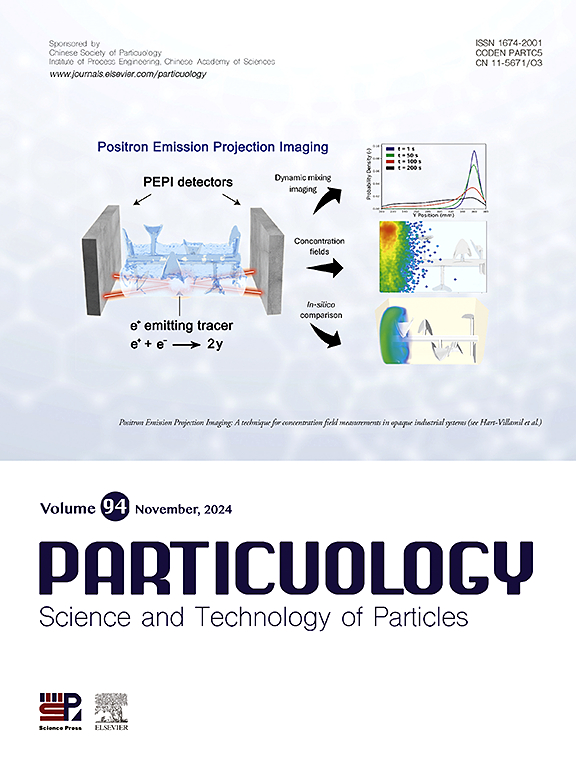Comparative study of deep learning techniques for predicting bubble dynamics in a gas-solid fluidized bed
IF 4.3
2区 材料科学
Q2 ENGINEERING, CHEMICAL
引用次数: 0
Abstract
The dynamic characteristics of bubbles are pivotal for the design and optimization of gas-solid fluidized beds. Common techniques for bubble analysis include direct photography, Electrical Capacitance Tomography (ECT), and X-ray imaging, among others. Traditional image segmentation methods often struggle to accurately process a substantial number of digital images within complex background environments. This paper presents a deep learning-based semantic segmentation methodology specifically designed for bubble segmentation in gas/iron ore powder fluidized beds and assesses the segmentation performance of five distinct deep learning models. Based on training outcomes, the DeepLabV3+ model utilizing a ResNet50 backbone demonstrates superior performance. Building upon this optimal deep learning model, various kinetic characteristics of bubbles, including equivalent diameter, size distribution, aspect ratio, bed voidage, and rising velocity, are analyzed at different fluidization numbers (n = 1.5, 2, 2.5, 3) within a quasi-2D fluidized bed setup. The findings indicate that the fluidization number significantly affects the evolution of bubble size and equivalent diameter in the fluidized bed; notably, the average equivalent diameter tends to increase with height along the bed. Conversely, the influence of fluidization number on both bubble size distribution and aspect ratio distribution is relatively minor. As both fluidization number and height from the sieve plate increase, bed voidage rises while fluctuations intensify considerably. Furthermore, bubble rising velocity correlates positively with increasing equivalent diameter; however, it remains independent of fluidization number for bubbles of identical sizes.

深度学习技术在气固流化床气泡动力学预测中的比较研究
气泡的动态特性是气固流化床设计与优化的关键。气泡分析的常用技术包括直接摄影、电容断层扫描(ECT)和x射线成像等。传统的图像分割方法往往难以准确处理复杂背景环境中的大量数字图像。本文提出了一种基于深度学习的语义分割方法,专门用于气/铁矿粉流化床中的气泡分割,并评估了五种不同深度学习模型的分割性能。基于训练结果,利用ResNet50骨干网的DeepLabV3+模型显示出优越的性能。基于该优化深度学习模型,在准二维流化床装置中,分析了不同流化数(n = 1.5、2、2.5、3)下气泡的各种动力学特性,包括等效直径、尺寸分布、长径比、床层空隙率和上升速度。结果表明:流化数对流化床内气泡尺寸和当量直径的演化有显著影响;值得注意的是,平均当量直径有随高度增加的趋势。相反,流化数对气泡尺寸分布和展弦比分布的影响相对较小。随着流化数和离筛板高度的增加,床层空隙增大,波动明显加剧。气泡上升速度与等效直径的增大呈正相关;然而,对于相同尺寸的气泡,它不受流化数的影响。
本文章由计算机程序翻译,如有差异,请以英文原文为准。
求助全文
约1分钟内获得全文
求助全文
来源期刊

Particuology
工程技术-材料科学:综合
CiteScore
6.70
自引率
2.90%
发文量
1730
审稿时长
32 days
期刊介绍:
The word ‘particuology’ was coined to parallel the discipline for the science and technology of particles.
Particuology is an interdisciplinary journal that publishes frontier research articles and critical reviews on the discovery, formulation and engineering of particulate materials, processes and systems. It especially welcomes contributions utilising advanced theoretical, modelling and measurement methods to enable the discovery and creation of new particulate materials, and the manufacturing of functional particulate-based products, such as sensors.
Papers are handled by Thematic Editors who oversee contributions from specific subject fields. These fields are classified into: Particle Synthesis and Modification; Particle Characterization and Measurement; Granular Systems and Bulk Solids Technology; Fluidization and Particle-Fluid Systems; Aerosols; and Applications of Particle Technology.
Key topics concerning the creation and processing of particulates include:
-Modelling and simulation of particle formation, collective behaviour of particles and systems for particle production over a broad spectrum of length scales
-Mining of experimental data for particle synthesis and surface properties to facilitate the creation of new materials and processes
-Particle design and preparation including controlled response and sensing functionalities in formation, delivery systems and biological systems, etc.
-Experimental and computational methods for visualization and analysis of particulate system.
These topics are broadly relevant to the production of materials, pharmaceuticals and food, and to the conversion of energy resources to fuels and protection of the environment.
 求助内容:
求助内容: 应助结果提醒方式:
应助结果提醒方式:


